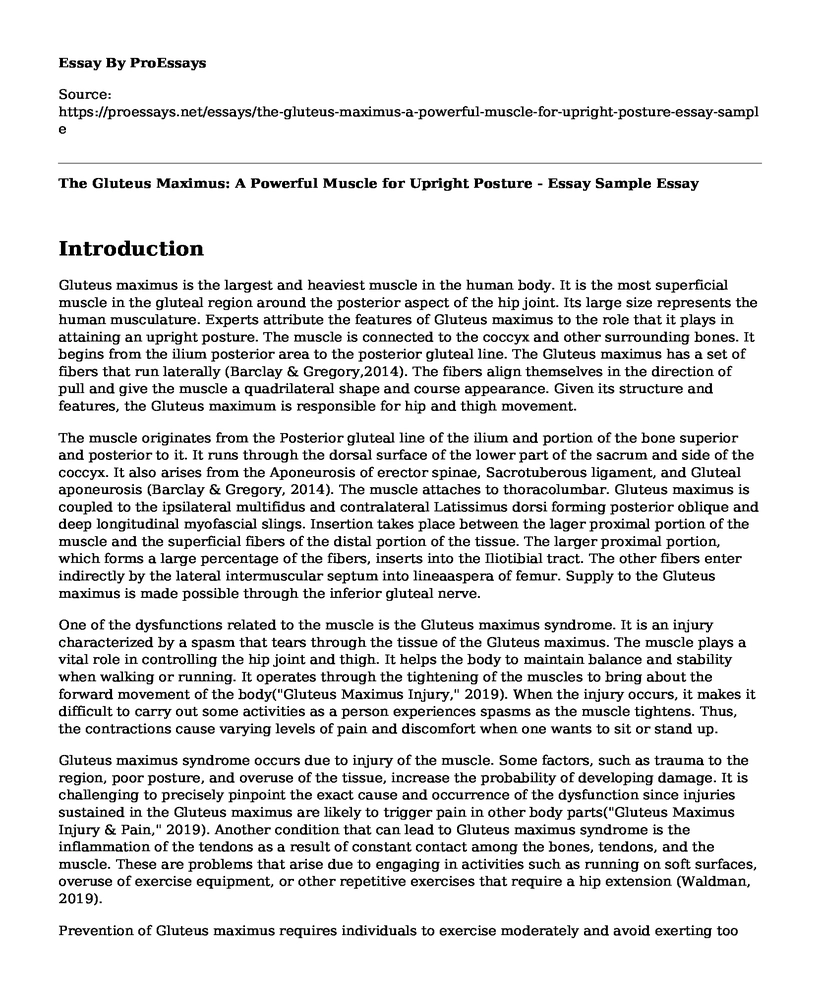Introduction
Gluteus maximus is the largest and heaviest muscle in the human body. It is the most superficial muscle in the gluteal region around the posterior aspect of the hip joint. Its large size represents the human musculature. Experts attribute the features of Gluteus maximus to the role that it plays in attaining an upright posture. The muscle is connected to the coccyx and other surrounding bones. It begins from the ilium posterior area to the posterior gluteal line. The Gluteus maximus has a set of fibers that run laterally (Barclay & Gregory,2014). The fibers align themselves in the direction of pull and give the muscle a quadrilateral shape and course appearance. Given its structure and features, the Gluteus maximum is responsible for hip and thigh movement.
The muscle originates from the Posterior gluteal line of the ilium and portion of the bone superior and posterior to it. It runs through the dorsal surface of the lower part of the sacrum and side of the coccyx. It also arises from the Aponeurosis of erector spinae, Sacrotuberous ligament, and Gluteal aponeurosis (Barclay & Gregory, 2014). The muscle attaches to thoracolumbar. Gluteus maximus is coupled to the ipsilateral multifidus and contralateral Latissimus dorsi forming posterior oblique and deep longitudinal myofascial slings. Insertion takes place between the lager proximal portion of the muscle and the superficial fibers of the distal portion of the tissue. The larger proximal portion, which forms a large percentage of the fibers, inserts into the Iliotibial tract. The other fibers enter indirectly by the lateral intermuscular septum into lineaaspera of femur. Supply to the Gluteus maximus is made possible through the inferior gluteal nerve.
One of the dysfunctions related to the muscle is the Gluteus maximus syndrome. It is an injury characterized by a spasm that tears through the tissue of the Gluteus maximus. The muscle plays a vital role in controlling the hip joint and thigh. It helps the body to maintain balance and stability when walking or running. It operates through the tightening of the muscles to bring about the forward movement of the body("Gluteus Maximus Injury," 2019). When the injury occurs, it makes it difficult to carry out some activities as a person experiences spasms as the muscle tightens. Thus, the contractions cause varying levels of pain and discomfort when one wants to sit or stand up.
Gluteus maximus syndrome occurs due to injury of the muscle. Some factors, such as trauma to the region, poor posture, and overuse of the tissue, increase the probability of developing damage. It is challenging to precisely pinpoint the exact cause and occurrence of the dysfunction since injuries sustained in the Gluteus maximus are likely to trigger pain in other body parts("Gluteus Maximus Injury & Pain," 2019). Another condition that can lead to Gluteus maximus syndrome is the inflammation of the tendons as a result of constant contact among the bones, tendons, and the muscle. These are problems that arise due to engaging in activities such as running on soft surfaces, overuse of exercise equipment, or other repetitive exercises that require a hip extension (Waldman, 2019).
Prevention of Gluteus maximus requires individuals to exercise moderately and avoid exerting too much pressure on the thighs and hips. However, one can seek professional help for a detailed diagnosis. Depending on the extent of injury sustained, physicians can recommend the use of exercises or medication to help regulate or get rid of the spasms("Gluteus Maximus Muscle Function," 2015). Treatment of the syndrome can take place through physical therapy. The essence of the physical activity is to put pressure on the muscle to improve motion. Besides, some medications such as anti-inflammatory pills and injections can also help reduce tension and pain in the tissue("Gluteus Maximus Muscle Function," 2015). Failure to address the syndrome leads to pain in the hamstring, back, hip, and knee.
References
Barclay W. Bakkum, Gregory D. Cramer. (2014). Clinical Anatomy of the Spine, Spinal Cord, and Ans (Third Edition).
Gluteus Maximus Injury & Pain: Symptoms & Treatment - Video & Lesson Transcript (2019). Retrieved from https://study.com/academy/lesson/gluteus-maximus-injury-pain-symptoms-treatment.html
Gluteus Maximus Muscle Function, Origin and Anatomy 2015). Retrieved from https://www.healthline.com/human-body-maps/gluteus-maximus-muscle#1
Waldman, S. D. (2019). Atlas of uncommon pain syndromes e-book. Elsevier Health Sciences.
Cite this page
The Gluteus Maximus: A Powerful Muscle for Upright Posture - Essay Sample. (2023, Mar 03). Retrieved from https://proessays.net/essays/the-gluteus-maximus-a-powerful-muscle-for-upright-posture-essay-sample
If you are the original author of this essay and no longer wish to have it published on the ProEssays website, please click below to request its removal:
- Interaction Between Fungus and Plants Also Fungus and Animals Essay
- Genetic Technologies for Effective Care Essay
- Organic Food vs. Genetically Modified Food
- Analyzing Research Methodology
- Exploring the National Park: A Memorable Adventure - Essay Sample
- Essay Sample on Rivers: Dynamic Ecosystems from Headwaters to Mouth
- Essay Example on ESA Endangered Species Protection: 1600 Species Saved and Growing







